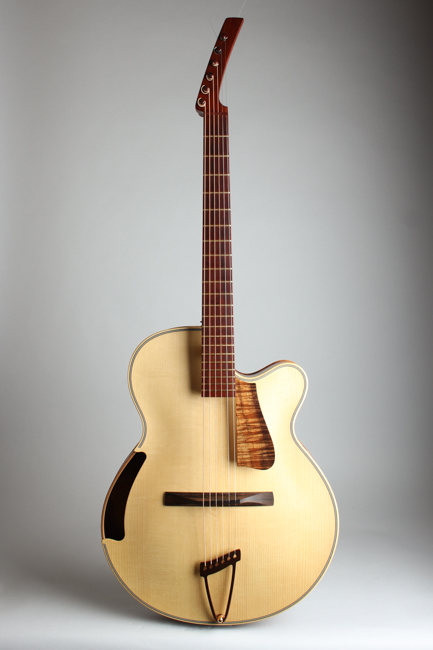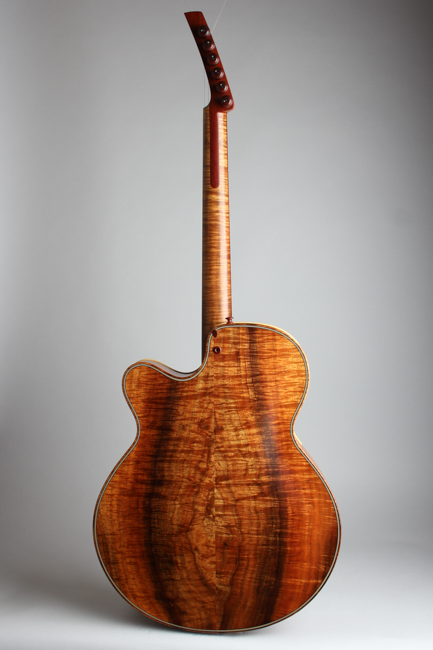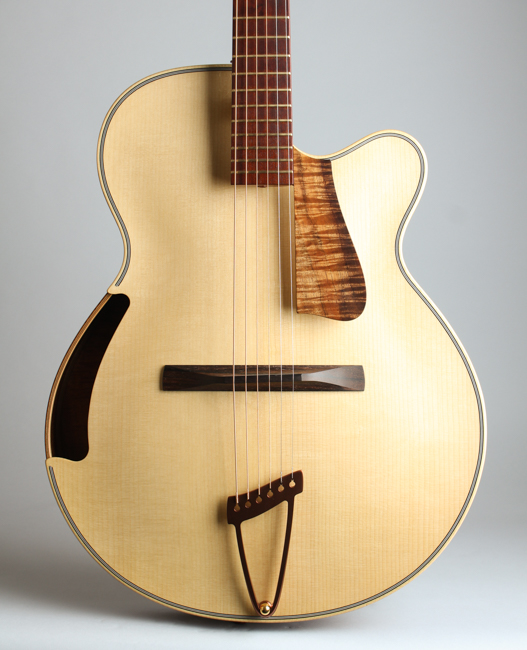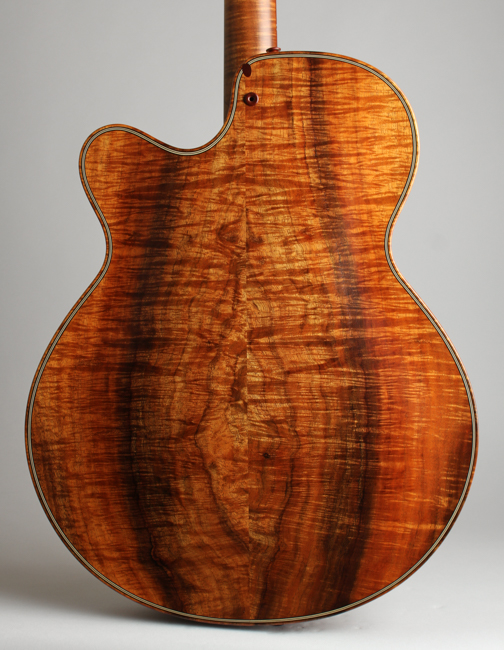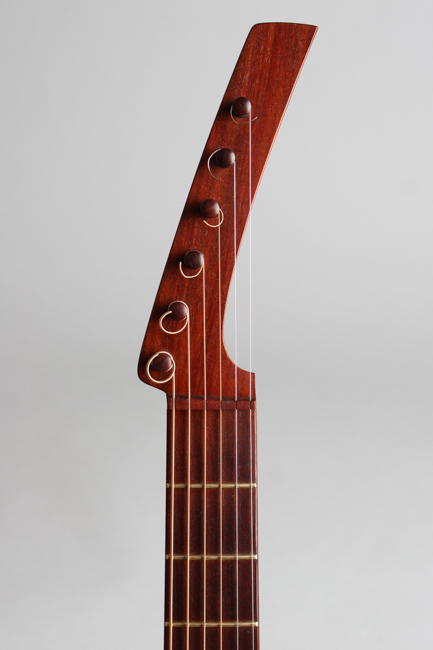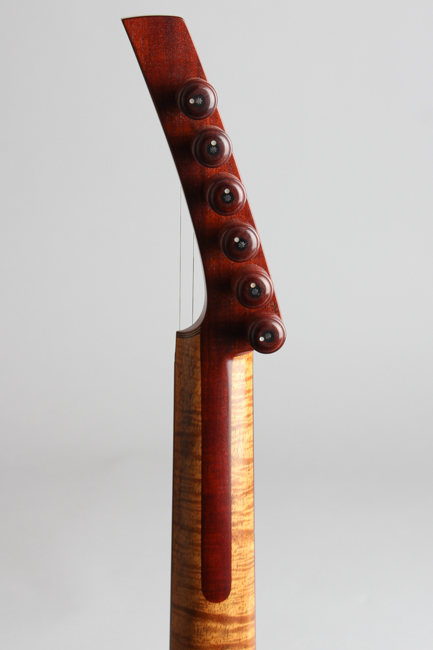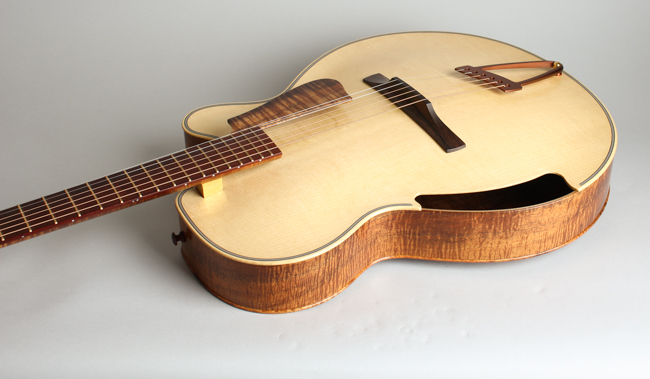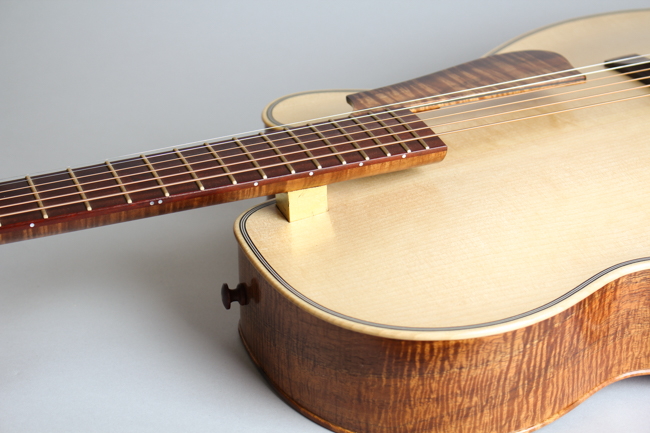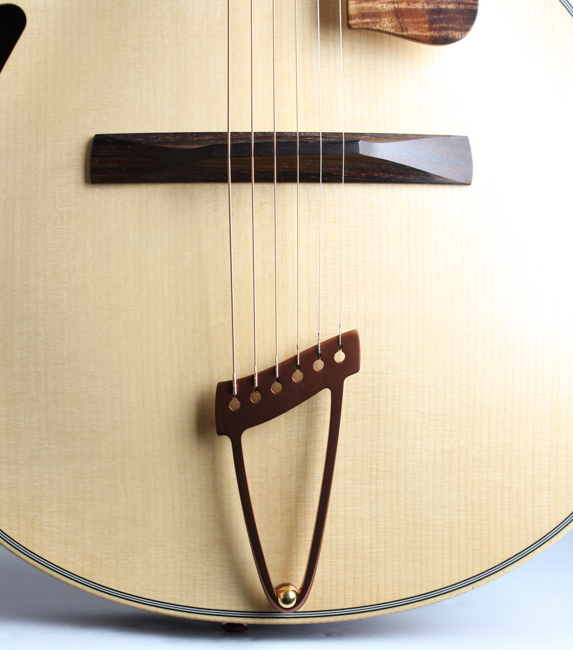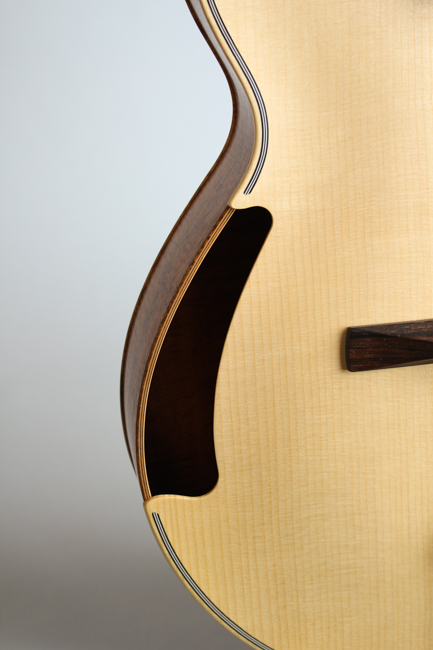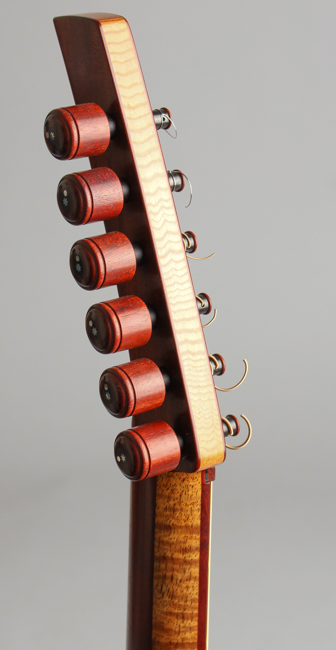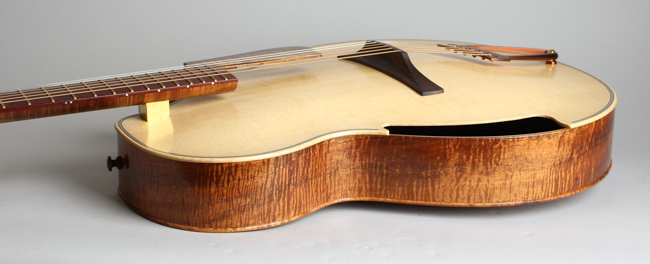Ken Parker Olive Branch Arch Top Acoustic Guitar (2006)
This item has been sold.
Item # 7391
Prices subject to change without notice.
Ken Parker Olive Branch Model Arch Top Acoustic Guitar (2006), natural finish, Red spruce top and braces. Koa back, sides, neck veneer, and pickguard overlay. Pernambuco fingerboard and headstock veneer. Brazilian rosewood bridge., original black Hoffee road case.
For the last 8 years, Ken Parker has devoted himself exclusively to the design and development of a new kind of archtop guitar. The guitars are individual pieces, not really models, and, although they do exhibit differences, they share the same outline, scale length, neck attachment, etc.
Some details specific to the Olive Branch:
Top: Red Spruce
Back, Sides, Pickguard, and Neck Veneer: Highly Figured Koa
Fingerboard, Head Veneers, Strap Buttons, and Other Bits: Pernambuco.
Neck Core: Douglas Fir
Tailpiece: Anodized Aluminum, adjustable for height*
Tuning pegs: 16:1 ratio planetary gears with specially designed Pernambuco knobs.
A small red olive is inlaid in the back.
16.5" across the lower bout
2.5" thick at the end block, 2.25" thick at the neck block
25.5" scale
Ken's own words on the fingerboards, necks, and body construction on his guitars:
About fingerboards:
In order for any stringed instrument to play optimally, the fingerboard surface must be shaped to address each string’s path and cross sectional shape when played. Because the string spacing is much greater at the bridge than at the nut, and therefore the strings are not parallel, the correct surface is always a conical section. There is no way that a “flat”, or constant - arc (cylindrical) surface can do the job, although that doesn’t stop most manufacturers from ignoring this fact to save money.
Every bowed instruments’ fingerboard, from Medieval to Modern, has been shaped in this conical way. Tragic - comically, this conical surface has been mis-named a “compound radius” by the guitar magazine pundits. To listen to them, you might get the idea that this was discovered in California in the 1970’s. As you know, a radius is a simple straight line measurement, and cannot be a compound anything!
I use a subtly altered conical section, just like the Medieval Viol builders did. The subtle alteration is a very slight longitudinal “hollow” parabolic curve to accommodate the shape of the vibrating strings, especially the lower notes of each string. This curve is called “relief” , and needs to be greater for heavy strings, high action, and an aggressive attack; and less for low action, light strings, and a light touch. The lower pitched strings always need slightly greater relief than the high strings. Precisely adjusting the relief to address these parameters is the key to optimal playability and low action. For the most demanding players, it’s necessary to observe quite strict temperature and relative humidity control in order to minimize wood movement that would affect the shape of the neck.
I normally use a 12”r at the 12th fret, which, combined with the difference between the string spacing at the nut and the bridge, gives 10.3”r at the nut, around 13”r at the 22nd fret, and 14”r at the bridge. Of course, this can be altered to suit the customers’ desires.
I use EVO fretwire, an exceptional product from the German company Mnzerna, which has a beautiful gold color, and outwears nickel fretwire many times.
I’m using the medium size, which is .090 wide, and .050 high. Because I work very carefully to shape the ebony fingerboard playing surface, virtually no height is lost to fret leveling.
I must say that I get very few comments about these things when I hand someone a guitar. I usually have to ask at least twice to get a comment on the neck, frets, or board arc. This is a good sign that the whole is greater than the sum of its’ parts.
Action is my speciality. I’m obsessed with action and playability. I understand that all of us are constructed differently, and I have devoted a big chunk of my worklife to facilitate the guitarist’s healthy and long - term interaction with the instrument. I can get an electric guitar to play perfectly at 1mm bass, .75 mm treble @ the 12th, but for expressive purposes, this action is too low to get a desirable dynamic range from an acoustic guitar. I normally build the guitar for D’Addario EXP (coated)Phosphor Bronze strings “012” - .053”. As a builder, I believe these strings to be superior to all others.
About neck stability:
I believe that neck stiffness is very important, especially contributing to even response. If the neck is too weak, it can cause all kinds of chaos. It’s also useful to remember that your hand is constantly modifying the behavior of the neck as it moves along it, as it acts as a fleshy nodal point.
The attractiveness of lower tuning peg weight for me is largely for physical balance. When you think of the guitar body’s waist as a fulcrum, the tuning pegs are quite far away, and exert a force much larger than their weight might suggest at first glance.
Why I recommend 12 gauge strings:
I’ve been at this repair/building thing for 35 years, and have worked for many guitarists who have had soft tissue problems that spoiled their ability to play. The sad part is that everything is fine until it isn’t, and then there’s no going back and doing it differently. In my opinion, based on this experience, 13s are too much for many of us, and it’s kinder on the body to consider the organism’s limitations. What a tragedy to be unable to play or practice the way you would like! I believe that the curves of humans and guitars cross at 12s, and have designed the guitars to respond optimally to the tension of this set. In my experience, shifting to 11s cuts the output greatly, but so does shifting to 13s! The greater force applied to the top seems to clamp it so hard that it’s no longer as sensitive, and tends to bark more than ring. “Clamped Shut” is what the guitars sound like to me when they see too much downpressure.
The guitar, unlike a bowed instrument, has to be very efficient to have any useful dynamic range. The difference between the most powerful guitar and a “normal” good guitar isn’t a huge difference. In order to offer the player a useful dynamic range, it’s necessary to build a powerful instrument that also sounds great at low volume, and is easy to “start” at low volume. This condition I think of as efficiency, and it has a lot to do with the relationship of the strength of the body relative to the downbearing force of the strings.
In 2003, when I began defining my design goals for the acoustic archtop, the neck attachment was one of my prime targets. The normal neck/body intersection on the archtop guitar has some built-in problems that I was called upon to address many times as a guitar repairman. I won't get too far into what these are, but they were problematic enough for me to try to develop a new and better solution for this important intersection.
I spent over a year testing and developing the techniques and tools that I now use to make this unique attachment/adjustment system. This system was wholly developed by me and I know of no other that approaches it in performance and versatility.
I feel the need to explain some of the details of this mechanism, as many of you have expressed curiosity about how it can work, and why I chose such a new path over the tried & true archtop heel / dovetail / glued foot design.
Here's a list of my original design goals, in rough order of their importance to me;
• Free the bridge from the burden of adjusting the action. The bridge is a crucial element in the sound path, and is spoiled, not improved by the inclusion of knurled adjusters riding on tiny pieces of threaded rod, or the now popular and odd looking "chopstick" action adjusting wedges. This freedom allows me to optimize the bridge's ability to transfer the strings' complex vibratory energy to the top without the compromise of including an elevating mechanism. I remove lots of material from the underside of the bridge to reduce it's weight (typically less than 30 grams), so that the bridge resembles a tent structure. This low mass bridge seems to improve the instrument's response at both the low and the high end of its' dynamic range.
• Construct and attach the neck in a way that solves the problems of slow but inevitable distortion ("creep" is the engineering term for this) in the neckblock area. My new method substantially increases the stiffness of the neck joint, and improves the energy transfer by minimizing losses. Many of you have wondered if the connecting post is strong enough to do the job. The post is constructed of carbon fibers in a matrix of high performance aerospace epoxy, and cannot creep over time. This carbon / epoxy reinforcement continues throughout the neck, and contributes substantially to the unprecedented evenness of response and lack of dead spots in these instruments.
• Allow the player to easily adjust the string action to balance comfort and output without the need to retune the instrument (see Sylvain Luc clip)
• Give complete access to the upper register by eliminating the entire heel structure
• Eliminate the bonding of the neck foot to the top, freeing the top and neck block to vibrate better
• Make the neck easily removable. This is nothing new. "Bolt - on" necks have been used to ease the long distance transport of bass violins since the 1500s. Using a combination of wood, carbon fiber, and epoxy, I've been able to optimize this structure for the archtop guitar.
Overall length is 42 3/4 in. (108.6 cm.), 16 in. (40.6 cm.) wide at lower bout, and 2 1/2 in. (6.4 cm.) in depth at side, taken at the end block. Scale length is 25 1/2 in. (648 mm.). Width of nut is 1 11/16 in. (43 mm.). Near Mint Condition.
For the last 8 years, Ken Parker has devoted himself exclusively to the design and development of a new kind of archtop guitar. The guitars are individual pieces, not really models, and, although they do exhibit differences, they share the same outline, scale length, neck attachment, etc.
Some details specific to the Olive Branch:
Top: Red Spruce
Back, Sides, Pickguard, and Neck Veneer: Highly Figured Koa
Fingerboard, Head Veneers, Strap Buttons, and Other Bits: Pernambuco.
Neck Core: Douglas Fir
Tailpiece: Anodized Aluminum, adjustable for height*
Tuning pegs: 16:1 ratio planetary gears with specially designed Pernambuco knobs.
A small red olive is inlaid in the back.
16.5" across the lower bout
2.5" thick at the end block, 2.25" thick at the neck block
25.5" scale
Ken's own words on the fingerboards, necks, and body construction on his guitars:
About fingerboards:
In order for any stringed instrument to play optimally, the fingerboard surface must be shaped to address each string’s path and cross sectional shape when played. Because the string spacing is much greater at the bridge than at the nut, and therefore the strings are not parallel, the correct surface is always a conical section. There is no way that a “flat”, or constant - arc (cylindrical) surface can do the job, although that doesn’t stop most manufacturers from ignoring this fact to save money.
Every bowed instruments’ fingerboard, from Medieval to Modern, has been shaped in this conical way. Tragic - comically, this conical surface has been mis-named a “compound radius” by the guitar magazine pundits. To listen to them, you might get the idea that this was discovered in California in the 1970’s. As you know, a radius is a simple straight line measurement, and cannot be a compound anything!
I use a subtly altered conical section, just like the Medieval Viol builders did. The subtle alteration is a very slight longitudinal “hollow” parabolic curve to accommodate the shape of the vibrating strings, especially the lower notes of each string. This curve is called “relief” , and needs to be greater for heavy strings, high action, and an aggressive attack; and less for low action, light strings, and a light touch. The lower pitched strings always need slightly greater relief than the high strings. Precisely adjusting the relief to address these parameters is the key to optimal playability and low action. For the most demanding players, it’s necessary to observe quite strict temperature and relative humidity control in order to minimize wood movement that would affect the shape of the neck.
I normally use a 12”r at the 12th fret, which, combined with the difference between the string spacing at the nut and the bridge, gives 10.3”r at the nut, around 13”r at the 22nd fret, and 14”r at the bridge. Of course, this can be altered to suit the customers’ desires.
I use EVO fretwire, an exceptional product from the German company Mnzerna, which has a beautiful gold color, and outwears nickel fretwire many times.
I’m using the medium size, which is .090 wide, and .050 high. Because I work very carefully to shape the ebony fingerboard playing surface, virtually no height is lost to fret leveling.
I must say that I get very few comments about these things when I hand someone a guitar. I usually have to ask at least twice to get a comment on the neck, frets, or board arc. This is a good sign that the whole is greater than the sum of its’ parts.
Action is my speciality. I’m obsessed with action and playability. I understand that all of us are constructed differently, and I have devoted a big chunk of my worklife to facilitate the guitarist’s healthy and long - term interaction with the instrument. I can get an electric guitar to play perfectly at 1mm bass, .75 mm treble @ the 12th, but for expressive purposes, this action is too low to get a desirable dynamic range from an acoustic guitar. I normally build the guitar for D’Addario EXP (coated)Phosphor Bronze strings “012” - .053”. As a builder, I believe these strings to be superior to all others.
About neck stability:
I believe that neck stiffness is very important, especially contributing to even response. If the neck is too weak, it can cause all kinds of chaos. It’s also useful to remember that your hand is constantly modifying the behavior of the neck as it moves along it, as it acts as a fleshy nodal point.
The attractiveness of lower tuning peg weight for me is largely for physical balance. When you think of the guitar body’s waist as a fulcrum, the tuning pegs are quite far away, and exert a force much larger than their weight might suggest at first glance.
Why I recommend 12 gauge strings:
I’ve been at this repair/building thing for 35 years, and have worked for many guitarists who have had soft tissue problems that spoiled their ability to play. The sad part is that everything is fine until it isn’t, and then there’s no going back and doing it differently. In my opinion, based on this experience, 13s are too much for many of us, and it’s kinder on the body to consider the organism’s limitations. What a tragedy to be unable to play or practice the way you would like! I believe that the curves of humans and guitars cross at 12s, and have designed the guitars to respond optimally to the tension of this set. In my experience, shifting to 11s cuts the output greatly, but so does shifting to 13s! The greater force applied to the top seems to clamp it so hard that it’s no longer as sensitive, and tends to bark more than ring. “Clamped Shut” is what the guitars sound like to me when they see too much downpressure.
The guitar, unlike a bowed instrument, has to be very efficient to have any useful dynamic range. The difference between the most powerful guitar and a “normal” good guitar isn’t a huge difference. In order to offer the player a useful dynamic range, it’s necessary to build a powerful instrument that also sounds great at low volume, and is easy to “start” at low volume. This condition I think of as efficiency, and it has a lot to do with the relationship of the strength of the body relative to the downbearing force of the strings.
In 2003, when I began defining my design goals for the acoustic archtop, the neck attachment was one of my prime targets. The normal neck/body intersection on the archtop guitar has some built-in problems that I was called upon to address many times as a guitar repairman. I won't get too far into what these are, but they were problematic enough for me to try to develop a new and better solution for this important intersection.
I spent over a year testing and developing the techniques and tools that I now use to make this unique attachment/adjustment system. This system was wholly developed by me and I know of no other that approaches it in performance and versatility.
I feel the need to explain some of the details of this mechanism, as many of you have expressed curiosity about how it can work, and why I chose such a new path over the tried & true archtop heel / dovetail / glued foot design.
Here's a list of my original design goals, in rough order of their importance to me;
• Free the bridge from the burden of adjusting the action. The bridge is a crucial element in the sound path, and is spoiled, not improved by the inclusion of knurled adjusters riding on tiny pieces of threaded rod, or the now popular and odd looking "chopstick" action adjusting wedges. This freedom allows me to optimize the bridge's ability to transfer the strings' complex vibratory energy to the top without the compromise of including an elevating mechanism. I remove lots of material from the underside of the bridge to reduce it's weight (typically less than 30 grams), so that the bridge resembles a tent structure. This low mass bridge seems to improve the instrument's response at both the low and the high end of its' dynamic range.
• Construct and attach the neck in a way that solves the problems of slow but inevitable distortion ("creep" is the engineering term for this) in the neckblock area. My new method substantially increases the stiffness of the neck joint, and improves the energy transfer by minimizing losses. Many of you have wondered if the connecting post is strong enough to do the job. The post is constructed of carbon fibers in a matrix of high performance aerospace epoxy, and cannot creep over time. This carbon / epoxy reinforcement continues throughout the neck, and contributes substantially to the unprecedented evenness of response and lack of dead spots in these instruments.
• Allow the player to easily adjust the string action to balance comfort and output without the need to retune the instrument (see Sylvain Luc clip)
• Give complete access to the upper register by eliminating the entire heel structure
• Eliminate the bonding of the neck foot to the top, freeing the top and neck block to vibrate better
• Make the neck easily removable. This is nothing new. "Bolt - on" necks have been used to ease the long distance transport of bass violins since the 1500s. Using a combination of wood, carbon fiber, and epoxy, I've been able to optimize this structure for the archtop guitar.
Overall length is 42 3/4 in. (108.6 cm.), 16 in. (40.6 cm.) wide at lower bout, and 2 1/2 in. (6.4 cm.) in depth at side, taken at the end block. Scale length is 25 1/2 in. (648 mm.). Width of nut is 1 11/16 in. (43 mm.). Near Mint Condition.
